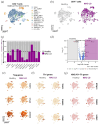Recombinant interleukin-7 treatment of refractory Mycobacterium avium complex lung disease (IMPULSE-7): a pilot phase II, single-center, randomized, clinical trial
- PMID: 40351870
- PMCID: PMC12065982
- DOI: 10.1177/20499361251339300
Recombinant interleukin-7 treatment of refractory Mycobacterium avium complex lung disease (IMPULSE-7): a pilot phase II, single-center, randomized, clinical trial
Abstract
Background: Nontuberculous mycobacteria disease is an emerging opportunistic infection that is often refractory to therapy. Interleukin 7 (IL-7) is a pleiotropic cytokine with broad-ranging effects that enhance immunity and augment monocyte/macrophage anti-Mycobacterium avium killing in vitro.
Objectives: This study evaluated IL-7 in patients with refractory Mycobacterium avium complex lung disease (MAC-LD).
Design: Prospective, single-center, randomized, study of IL-7 in patients with refractory MAC-LD.
Methods: Randomization (two sets of 4 weekly IL-7 injections) was stratified based on the presence of pulmonary cavities. The primary outcome was sputum culture conversion to negative within 6 months. Exploratory outcomes included investigation of potential molecular mechanisms of immunosuppression via single-cell RNA sequencing (scRNA-seq).
Results: Of the eight participants enrolled, six completed the IL-7 regimen, one completed one 4-week therapy, and one received a single dose of IL-7. All six participants who completed the regimen showed an increased absolute lymphocyte count (ALC), yet none converted their sputum culture to negative at 6 months. Similarly, there were no differences in secondary outcomes compared to baseline. IL-7 was well tolerated, and two participants showed an increase in time-positivity for MAC in their sputum culture. scRNA-seq revealed increased expression of genes involved in immunosuppressive pathways.
Conclusion: In adults with refractory MAC-LD, IL-7 did not result in sputum culture conversion. IL-7 reversed the underlying lymphopenia associated with MAC-LD and led to a sustained increase in ALC. The study was limited by a small sample size, and although a longer course of IL-7 combined with newer antimicrobials for may warrant further investigation, structural lung disease may be a stronger predictor of cure than immune dysfunction in MAC-LD.
Trial registration: The trial was registered in clinicaltrials.gov (NCT04154826).
Keywords: IL-7; NTM; nontuberculous mycobacteria; pulmonary disease; randomized clinical trial; refractory.
Plain language summary
IL-7 for refractory MAC lung disease (IMPULSE-7) We present the results of a proof-of-concept trial that investigated the use of recombinant IL-7 as an adjuvant host-directed therapy for the treatment of refractory Mycobacterium avium complex lung disease (MAC-LD). Unfortunately, this was a negative study, limited by the small number of patients included, as we stopped recruitment early due to the lack of a clinical signal suggesting that IL-7 would be effective in achieving the primary outcome. However, we believe it is important to publish negative studies to help researchers explore alternative pathways in the management of refractory MAC-LD, where therapies to achieve microbiological cure are greatly needed.
© The Author(s), 2025.
Figures


References
-
- Falkinham JO, III. Environmental sources of nontuberculous mycobacteria. Clin Chest Med 2015; 36(1): 35–41. - PubMed
-
- Dahl VN, Molhave M, Floe A, et al.. Global trends of pulmonary infections with nontuberculous mycobacteria: a systematic review. Int J Infect Dis 2022; 125: 120–131. - PubMed
-
- Haworth CS, Banks J, Capstick T, et al.. British Thoracic Society guidelines for the management of non-tuberculous mycobacterial pulmonary disease (NTM-PD). Thorax 2017; 72(Suppl. 2): ii1–ii64. - PubMed
-
- Lam PK, Griffith DE, Aksamit TR, et al.. Factors related to response to intermittent treatment of Mycobacterium avium complex lung disease. Am J Respir Crit Care Med 2006; 173(11): 1283–1289. - PubMed
Associated data
LinkOut - more resources
Full Text Sources
Medical
Research Materials

